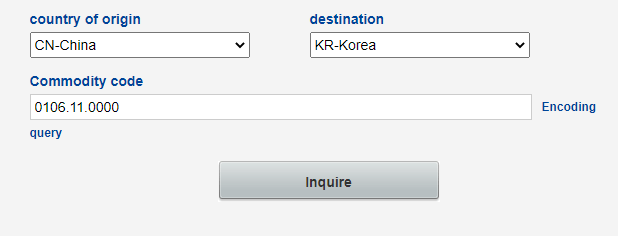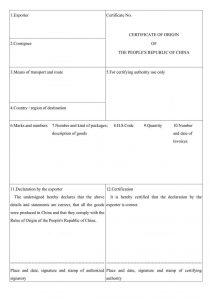During the import and export customs clearance, Certificate of Origin is one of the essential documents for all kinds of goods. It is the basis of affirming the origin of the products and tariff treatment.
As an importer, you must know this term clearly. This guide will give you detailed and complete explains of this important certificate. Let’s get started.
1. What is Certificate of Origin?
Certificate of Origin is a required document for all kinds of products to handle customs clearance. It can affirm the original countries or regions where the products are manufactured, and processed. Sometimes, without this country of origin certificate, it is impossible to import or export the goods.
Moreover, this document is backed by the International Chamber of Commerce (ICC). It is a global organization that is responsible for enacting and publishing globally accepted guidelines for Certificates of Origin.
2. Purpose of Certificate of Origin
As we have mentioned above, a certificate of origin will be helpful for your business. In this section, I’ll explain to you in detail. There are mainly 3 functions of this document:
To verify the original country of the goods
Like a “passport” of the product, it can show its “nationality” during customs clearance. Some countries have restrictions on imported products from other countries. Thus, they need a certificate to verify the origin of the products and conduct the trade control.
For example, because of the US sanction against Iran, some products made in Iran imported to America are banned or limited strictly.
To claim the preferential import duty
Many countries have signed mutual trading agreements with their exporting and importing partners. Thus, importers can use these preferential agreements to reduce their import duties. Many companies regard this free trade certificate as paper gold due to this function.
For example, China and Pakistan have signed The China–Pakistan Free Trade Agreement (CPFTA). If you want to import goods from China to Pakistan, the Chinese manufacturers can apply for Certificate of Origin China-Pakistan FTA (FORM P). Then, they can receive preferential tariffs or even zero tariffs when importing to Pakistan.
Of course, the preferential duty will vary from different countries and products. To check the conventional tariff in detail, you can check China FTA Network and find the tariff calculator to help you. But this tool only has a Chinese version. If you want to use it, you should translate it into English first.

To verify the qualification of the shipping
This certificate plays a significant role in the inspections and authentication of the shipment. It provides all the details regarding the shipping so that the inspectors can easily and quickly verify that the shipping is permitted legally in the importing country.
3. Four Types of Certificate of Origin in China
When you consider importing goods from China, you should know what types of Certificate of Origin you can get from China. It may be beneficial for your business. In China, there are 4 types of Certificates of Origin.
Non-preferential Certificate of Origin
It is also known as the General Certificate of Origin (C/O). It is issued to declare that the manufacturing origin of goods is in China, and the products can only enjoy the general duty rate.
Only the two countries that have built up the “Most favored nation” relationships can the goods enjoy the preferential tariff treatment in the importing countries.
FORM A (G.S.P Certificate)
FORM A is short for Generalized System of Preferential Certificate of Origin FORM A. It is a one-way system that developed countries preferential tariffs or even zero tariffs to developing countries. It aims to help the developing countries expand their exports and accelerate their economic growth.
As a result of obtaining this certificate, the import duties on the Chinese exports are either reduced or completely waived off by the importing country. The duty rate will differ in various countries. Besides, the products must conform to the GSP Regulation.
Since 1978, 40 countries have ever provided trade privileges to China under the GSP system:
| Britain, France, Germany, Italy, Belgium, the Netherlands, Luxembourg, Ireland, |
| Denmark, Greece, Spain, Portugal, Austria, Sweden, Finland, Poland, Hungary |
| The Czech Republic, Slovakia, Slovenia, Estonia, Latvia, Lithuania, Cyprus, Malta, |
| Bulgaria, Romania, Switzerland, Liechtenstein, Norway, Russia’s Slovenia, Belarus |
| Ukraine, Kazakhstan, Japan, Australia, New Zealand, Canada, Turkey |
But the GSP system is not permanent. The developed countries can remove the preferential treatment if the developing countries don’t need the assistance. And so far, only 3 countries like Norway, New Zealand, Australia continue to give the GSP treatment to China.
Regional Preferential Certificate of Origin
Except for FORM A, there is another type of preferential certificate of origin. Regional preferential certificate of origin is used for tariff reduction or exemption mutually between the countries who have signed a trade agreement. The preferential duty of regional preferential certificate of origin is even better than FORM A.
Currently, there are 19 trade agreements with China, involving 29 countries and regions. Under these trade agreements, China can receive tariff preferences. And they can issue a regional preferential certificate of origin.
In the following, I list these types of free trade certificates and the countries for your reference:
| FORM P (Pakistan) | FORM S (Switzerland) |
| FORM F (Chile) | FORM L (Costa Rica) |
| FORM N (New Zealand) | FORM K (Korea) |
| FORM X (Singapore) | China-Austrilia FTA Certificate of Origin |
| China-Peru FTA Certificate of Origin | China-Iceland FTA Certificate of Origin |
| China-Georgia FTA Certificate of Origin | China- Mauritius FTA Certificate of Origin |
| China-Cambodia FTA Certificate of Origin | China- Maldives FTA Certificate of Origin |
Special Certificate of Origin
A special certificate of origin is for a specific category of goods like agricultural products, wine, tobacco, rough diamond, etc. Such products might be subject to some manufacturing and importing rules.
These certificates can also be multilateral. Namely, they may be acceptable in more than one country.
4. Elements Included in Certificate of Origin
In summary, a Certificate of Origin reports the following details:
- All the necessary information of the exporter
The information includes the name, company name, and business address. This information highlights the country/region of origin.
- All the necessary information of the consignee
The consignee is responsible for the receipt of the shipment. This information highlights the country/region of destination.
- The detailed shipment information
It includes the modes of transport, routes, the destinations of the shipping, and the shipping firm and transshipments.
- Information of the third party
CO is certified by an independent and approved third party. Therefore, it contains the required information regarding such a party.
- Information on the shipment
This information includes the number and kinds of packages, descriptions, quantities, and measurements of goods.
- Declaration by the exporter
The certificate includes the exporter’s stamp and signature. And it also needs the issuing date and the place of the CO.
- Additional essential information
The information includes customs declaration and the marks and numbers for invoicing purposes.
Click the blank certificate of origin template below to check the details.
5. Who Can Issue Certificate of Origin in China?
There are mainly two bodies helping you get certificates of origin in China. These include China Customs and the China Council for the Promotion of International Trade (CCPIT). These are the only two authorized offices for issuing the certificate in China. Other agents have no authority.

- China Customs
- CCPIT
China customs is the official Chinese government body and can issue all preferential and non-preferential certificates of origin. The CCPIT, short for the China Chamber of Commerce, can issue all non-preferential and most preferential certificates of origin.
6. Other Types of Certificates Without a CO
Additionally, you can obtain the following certificates if you don’t have preferential or non-preferential COs.
Certificate of Processing
Some Chinese exporters may fail to obtain a general certificate of origin due to the nature of their manufacturing. For instance, China may not be the processing and assembly place of the products. If this is the case, they have to obtain a Certificate of Processing.
Certificate of Re-export
This certificate is issued when the goods are neither manufactured nor assembled in China. They are imported as finished goods from other countries and are re-exported from China.
Final Words
If this blog is helpful for you, you can share it on your social communities to let more people know. If you have more questions, feel free to leave a comment below.
We’re Jingsourcing, a leading sourcing company in China. If you want to wholesale or customize products from China at very competitive prices, don’t hesitate to CONTACT US.
Further Knowledge about Certificate for Products


Leave A Comment